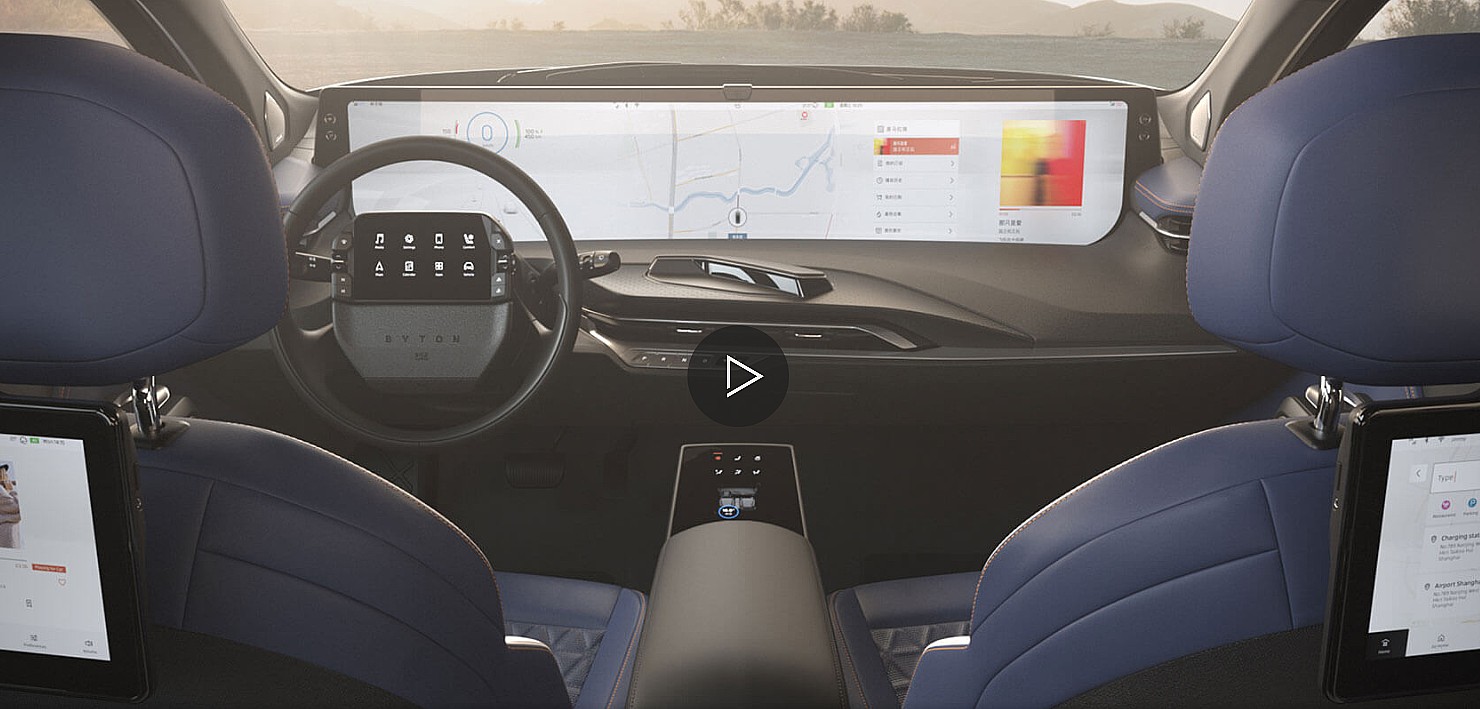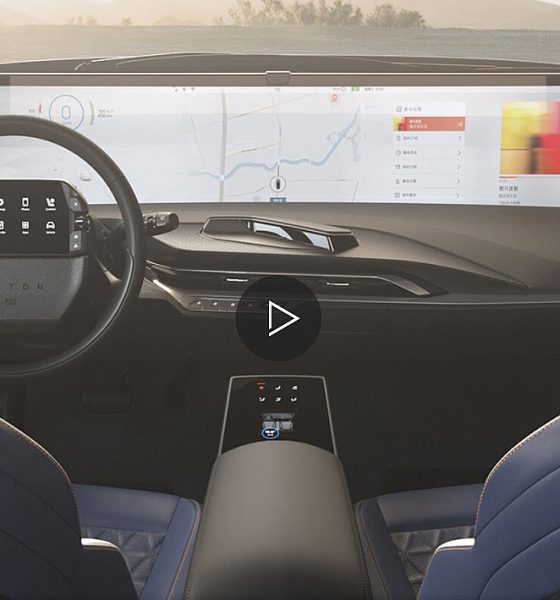

News
Aspiring Tesla rival Byton claims better tech, break even goal in 2-3 years after first EV production
Like several aspiring Tesla rivals before it, Byton aims to beat the Silicon Valley-based electric car maker at its own game. This means better tech, a lower price point, and a solid path to profitability without any of the growing pains that Tesla experienced over the years. Byton CEO Daniel Kirchert believes that his company has the goods to meet these goals, and perhaps even more.
In a recent interview, Kirchert noted that when preparing the M-Byte, Byton’s first vehicle, the CEO stated that the company focused so much on tech that it is poised to outdo Tesla in the segment. “We tried to jump at least one or two steps further,” he said, emphasizing that the company wanted to create a “smart device on wheels” with its first production vehicle.
Byton caught headlines when it unveiled its first concept vehicle’s interior, which was dominated by a massive display that stretched across the dashboard. The company has adopted this design on the M-Byte, which will likely be a competitor to the Tesla Model Y, Jaguar I-PACE, and the Ford Mustang Mach-E. Thus, the vehicle will have a 48-inch dashboard display, a touchpad on the steering wheel, and over-the-air updates.
For the Byton CEO, the M-Byte’s interior concept will be a “game-changer.” Far from being distracting, Kirchert stated that the 48-inch display would be the complete opposite of distracting. He noted that the massive screen would not obstruct the driver’s view while allowing drivers to quickly move their eyes from the road to the display and back. And since the display is 48 inches, it would be easier to read and comprehend the information on the screen.
But this is not all. The CEO also noted that it intends to avoid Tesla’s mistakes with the Model 3’s mass production, which was overly-automated at first. Thus, the company will follow tried and tested methods to build its cars. This, according to Kirchert, will allow Byton’s vehicles to have the same level of build quality with Germany’s best, such as Mercedes-Benz and BMW. In what appeared to be a slight stab at Tesla, the CEO also mentioned that the company would break even far quicker than the Elon Musk-led company.
“We were convinced right from the beginning that we won’t have 10 or 15 years to reach break-even,” he said. A company representative has further noted that Byton is aiming to reach the break-even point two to three years after it starts selling the M-Byte.
To make this possible, Kirchert noted that Byton would have to mass-produce the M-Byte in large numbers. This is the primary reason why the company is pricing the all-electric SUV at around $50,000, which is closer to the Model Y than other premium rivals like the Jaguar I-PACE.
It should be noted that while the Byton CEO’s statements are very optimistic, it is far more challenging to walk the walk than it is to talk the talk. Byton is not the only aspiring Tesla rival that has emerged. The line is long with companies such as Faraday Future and Lucid Motors. But despite the emergence of these companies, as well as the arrival of competing cars from established automakers such as the Audi e-tron, there are very few legitimate competitors to Tesla’s electric vehicles, even older ones like the Model S and Model X.
With this in mind, Byton may still need to learn a thing or two in practice before it can have a legitimate shot at beating Tesla at its own game. Still, the arrival of the M-Byte should be welcomed, as it is yet another electric vehicle that can help in getting petrol-powered SUVs off the road.

News
Tesla FSD fleet is nearing 7 billion total miles, including 2.5 billion city miles
As can be seen on Tesla’s official FSD webpage, vehicles equipped with the system have now navigated over 6.99 billion miles.

Tesla’s Full Self-Driving (Supervised) fleet is closing in on almost 7 billion total miles driven, as per data posted by the company on its official FSD webpage.
These figures hint at the massive scale of data fueling Tesla’s rapid FSD improvements, which have been quite notable as of late.
FSD mileage milestones
As can be seen on Tesla’s official FSD webpage, vehicles equipped with the system have now navigated over 6.99 billion miles. Tesla owner and avid FSD tester Whole Mars Catalog also shared a screenshot indicating that from the nearly 7 billion miles traveled by the FSD fleet, more than 2.5 billion miles were driven inside cities.
City miles are particularly valuable for complex urban scenarios like unprotected turns, pedestrian interactions, and traffic lights. This is also the difference-maker for FSD, as only complex solutions, such as Waymo’s self-driving taxis, operate similarly on inner-city streets. And even then, incidents such as the San Francisco blackouts have proven challenging for sensor-rich vehicles like Waymos.
Tesla’s data edge
Tesla has a number of advantages in the autonomous vehicle sector, one of which is the size of its fleet and the number of vehicles training FSD on real-world roads. Tesla’s nearly 7 billion FSD miles then allow the company to roll out updates that make its vehicles behave like they are being driven by experienced drivers, even if they are operating on their own.
So notable are Tesla’s improvements to FSD that NVIDIA Director of Robotics Jim Fan, after experiencing FSD v14, noted that the system is the first AI that passes what he described as a “Physical Turing Test.”
“Despite knowing exactly how robot learning works, I still find it magical watching the steering wheel turn by itself. First it feels surreal, next it becomes routine. Then, like the smartphone, taking it away actively hurts. This is how humanity gets rewired and glued to god-like technologies,” Fan wrote in a post on X.
News
Tesla starts showing how FSD will change lives in Europe
Local officials tested the system on narrow country roads and were impressed by FSD’s smooth, human-like driving, with some calling the service a game-changer for everyday life in areas that are far from urban centers.

Tesla has launched Europe’s first public shuttle service using Full Self-Driving (Supervised) in the rural Eifelkreis Bitburg-Prüm region of Germany, demonstrating how the technology can restore independence and mobility for people who struggle with limited transport options.
Local officials tested the system on narrow country roads and were impressed by FSD’s smooth, human-like driving, with some calling the service a game-changer for everyday life in areas that are far from urban centers.
Officials see real impact on rural residents
Arzfeld Mayor Johannes Kuhl and District Administrator Andreas Kruppert personally tested the Tesla shuttle service. This allowed them to see just how well FSD navigated winding lanes and rural roads confidently. Kruppert said, “Autonomous driving sounds like science fiction to many, but we simply see here that it works totally well in rural regions too.” Kuhl, for his part, also noted that FSD “feels like a very experienced driver.”
The pilot complements the area’s “Citizen Bus” program, which provides on-demand rides for elderly residents who can no longer drive themselves. Tesla Europe shared a video of a demonstration of the service, highlighting how FSD gives people their freedom back, even in places where public transport is not as prevalent.
What the Ministry for Economic Affairs and Transport says
Rhineland-Palatinate’s Minister Daniela Schmitt supported the project, praising the collaboration that made this “first of its kind in Europe” possible. As per the ministry, the rural rollout for the service shows FSD’s potential beyond major cities, and it delivers tangible benefits like grocery runs, doctor visits, and social connections for isolated residents.
“Reliable and flexible mobility is especially vital in rural areas. With the launch of a shuttle service using self-driving vehicles (FSD supervised) by Tesla in the Eifelkreis Bitburg-Prüm, an innovative pilot project is now getting underway that complements local community bus services. It is the first project of its kind in Europe.
“The result is a real gain for rural mobility: greater accessibility, more flexibility and tangible benefits for everyday life. A strong signal for innovation, cooperation and future-oriented mobility beyond urban centers,” the ministry wrote in a LinkedIn post.
News
Tesla China quietly posts Robotaxi-related job listing
Tesla China is currently seeking a Low Voltage Electrical Engineer to work on circuit board design for the company’s autonomous vehicles.

Tesla has posted a new job listing in Shanghai explicitly tied to its Robotaxi program, fueling speculation that the company is preparing to launch its dedicated autonomous ride-hailing service in China.
As noted in the listing, Tesla China is currently seeking a Low Voltage Electrical Engineer to work on circuit board design for the company’s autonomous vehicles.
Robotaxi-specific role
The listing, which was shared on social media platform X by industry watcher @tslaming, suggested that Tesla China is looking to fill the role urgently. The job listing itself specifically mentions that the person hired for the role will be working on the Low Voltage Hardware team, which would design the circuit boards that would serve as the nervous system of the Robotaxi.
Key tasks for the role, as indicated in the job listing, include collaboration with PCB layout, firmware, mechanical, program management, and validation teams, among other responsibilities. The role is based in Shanghai.
China Robotaxi launch
China represents a massive potential market for robotaxis, with its dense urban centers and supportive policies in select cities. Tesla has limited permission to roll out FSD in the country, though despite this, its vehicles have been hailed as among the best in the market when it comes to autonomous features. So far, at least, it appears that China supports Tesla’s FSD and Robotaxi rollout.
This was hinted at in November, when Tesla brought the Cybercab to the 8th China International Import Expo (CIIE) in Shanghai, marking the first time that the autonomous two-seater was brought to the Asia-Pacific region. The vehicle, despite not having a release date in China, received a significant amount of interest among the event’s attendees.








